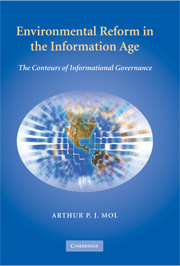Introduction: new frontiers of environmental governance
Published online by Cambridge University Press: 03 November 2009
Summary
For some, like the newspaper ‘The European’, the Agency might be seen as ‘a watch-dog without teeth’. Or as Lord Tordoff remarked recently, we could become ‘just an information black hole’. For others, who are aware of the power of information in our society, the Agency could go to the opposite extreme and become a concealed power center, a Trojan Horse.
Domingo Jimenez-Beltran, executive director of the EEA, 1995The dawn of a new era
Twelve years and more than sixty thousand orbits on from its launch, the Earth Observation mission of Europe's Space Association ESA, ERS-2 satellite, continues with all instruments functioning well. ERS-2 was launched on 21 April 1995, ensuring continuity of data from ERS-1, the first European Remote Sensing program mission. A growing global network of ground stations of more than three thousand users is receiving data from the veteran spacecraft ERS-2. When the Asian tsunami struck in December 2004, satellites provided rapid damage mapping. Another ERS-2 sensor working in near-real time is its Global Ozone Mapping Experiment (GOME), delivering atmospheric global coverage of ozone and other trace gases and supporting operational services such as Tropospheric Emission Monitoring Internet Service (TEMIS), which provides daily ozone, ultraviolet and air pollution monitoring. The latter functions are mainly supported by another satellite, Envisat. In March 2002, the European Space Agency launched Envisat, an advanced polar-orbiting earth observation satellite that provides measurements of the atmosphere, ocean, land and ice.
- Type
- Chapter
- Information
- Environmental Reform in the Information AgeThe Contours of Informational Governance, pp. 1 - 26Publisher: Cambridge University PressPrint publication year: 2008



